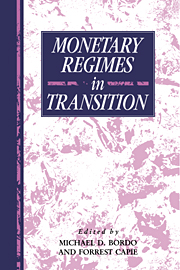Book contents
- Frontmatter
- Contents
- List of figures
- List of tables
- List of contributors
- 1 Introduction
- Part I Commodity money standards in transition
- Part II Successful and unsuccessful adherence to the gold standard
- Part III Wartime upheaval and postwar stabilization
- 8 British and French finance during the Napoleonic Wars
- 9 Interpreting a change in monetary policy regimes: a reappraisal of the first Hungarian hyperinflation and stabilization, 1921–28
- 10 Halting inflation in Italy and France after the Second World War
- 11 The rise and fall of credit controls: the case of Sweden, 1939–89
- Part IV Perspectives on monetary regimes
- Index
9 - Interpreting a change in monetary policy regimes: a reappraisal of the first Hungarian hyperinflation and stabilization, 1921–28
Published online by Cambridge University Press: 05 May 2010
- Frontmatter
- Contents
- List of figures
- List of tables
- List of contributors
- 1 Introduction
- Part I Commodity money standards in transition
- Part II Successful and unsuccessful adherence to the gold standard
- Part III Wartime upheaval and postwar stabilization
- 8 British and French finance during the Napoleonic Wars
- 9 Interpreting a change in monetary policy regimes: a reappraisal of the first Hungarian hyperinflation and stabilization, 1921–28
- 10 Halting inflation in Italy and France after the Second World War
- 11 The rise and fall of credit controls: the case of Sweden, 1939–89
- Part IV Perspectives on monetary regimes
- Index
Summary
Introduction
Hungary's experience during the 1920s offers an interesting illustration of failed attempts at transforming the rules governing monetary policy. In other words, they represent examples of unsuccessful changes in monetary regimes. This chapter reconsiders the first Hungarian hyperinflation and stabilization in light of previously unused historical evidence, as well as econometric evidence based on a time-series analysis of the period 1921–28. Three potentially distinct monetary regimes are considered: the so-called Hegedüs reforms of 1921, which produced a temporary change in the prevailing monetary regime; the hyperinflation of 1921–24; and the post-hyperinflationary period of 1924-28. According to the rational expectations hypothesis a successful change in a monetary regime can be brought about only if the public has credibility in the policy makers’ intentions. Otherwise, there is no reason for individuals to revise the future path of the variables of interest. Credibility is here denned as in Cukierman (1986, p. 6), as “the extent to which the public believes that a shift in policy has taken place when, indeed, such a shift has actually occurred.”
Unfortunately, as Dornbusch (1988) has argued, economists have no adequate theory of credibility. Indeed, the literature contains a number of studies which have reinterpreted Sargent's view of history by calling attention to a variety of historical attempts to arrest inflation that failed, but which appeared credible by Sargent's standards (see Siklos, 1990a for a survey).
It is for this reason that a mix of historical and statistical evidence is utilized in this chapter to gauge the significance of policy shifts during the period 1921-28. The present study argues that the 1921 reforms, previously largely ignored in the literature, produced a change in the monetary regime.
- Type
- Chapter
- Information
- Monetary Regimes in Transition , pp. 274 - 311Publisher: Cambridge University PressPrint publication year: 1993
- 4
- Cited by



